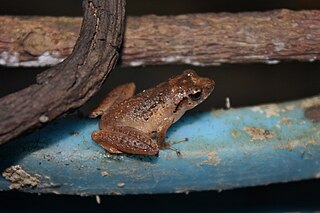
Polypedates is a genus of frogs in the family Rhacophoridae, the shrub frogs and Paleotropic tree frogs. They belong to subfamily Rhacophorinae. Members of this genus are collectively known as whipping frogs. They occur in eastern and southern Asia.

Romer's tree frog is a species of frog native to Hong Kong and a small portion of Guangxi, China. With an average snout-vent length of 1.5 – 2.5 cm, it is the smallest amphibian recorded in the territory. Despite its common name, it belongs to the family Rhacophoridae, instead of the Hylidae.

Polypedates maculatus, the Indian tree frog, or Chunam tree frog, is a common species of tree frog found in South Asia. It was described by John Edward Gray in 1830.

The northern red-legged frog is a species of amphibian whose range is the coastal region stretching from southwest British Columbia to southern Mendocino County in Northern California, and is protected in Oregon and California. As a member of the genus Rana, this species is considered a true frog, with characteristic smooth skin and a narrow waist. This frog requires still waters for breeding, and is rarely found at any great distance from its breeding ponds or marshes.

Boulenophrys brachykolos, the short-legged horned toad or Peak spadefoot toad, is a frog native to southern China and Vietnam. It was first discovered in the Victoria Peak, Hong Kong. Many populations of Hong Kong are in the country parks, such as Lung Fu Shan Country Park.

Wallace's flying frog, also known as the gliding frog or the Abah River flying frog, is a moss frog found at least from the Malay Peninsula into western Indonesia, and is present in Borneo and Sumatra. It is named for the biologist, Alfred R. Wallace, who collected the first known specimen.

Philautus hosii is a species of frog in the family Rhacophoridae. It is endemic to Borneo and has been found at 1,351 m (4,432 ft) above sea level. The specific name of the synonym, Polypedates chlorophthalmus, refers to its "remarkable green iris", from the Greek for "green-eyed". Accordingly, the common name green-eyed tree frog has been coined for the species.

Polypedates colletti is a species of frog in the family Rhacophoridae. It is found in the Malay Peninsula, southern Vietnam, Borneo, Sumatra, and islands of the South China Sea.

Polypedates cruciger is a species of frog in the family Rhacophoridae endemic to Sri Lanka. It has been osbserved as high as 1600 meters above sea level.

Taruga eques is a species of frog in the family Rhacophoridae. It is endemic to the central hills of Sri Lanka.

Polypedates leucomystax is a species in the shrub frog family Rhacophoridae. It is known under numerous common names, including common tree frog, four-lined tree frog, golden tree frog or striped tree frog. Many past authors have united it with the common Indian tree frog in P. maculatus, but today they are generally considered distinct species. In its native range, it is also called "white-lipped tree frog", but this name is otherwise applied to a species of true tree frogs.

Polypedates macrotis, commonly known as the dark-eared treefrog, sometimes also Bongao tree frog, Bongao bubble-nest frog, Baram whipping frog, or brown-striped tree frog, is a species of frog in the family Rhacophoridae. It is found in the central peninsular Thailand, Sumatra, Borneo, and Sulu Archipelago as well as a range of other Philippine islands.
Polypedates mutus is a species of frog in the family Rhacophoridae. It is found in southern and southwestern China, Myanmar, Laos, Thailand, and Vietnam. However, it may actually represent two different species. It is not known which one of these is the "true" Polypedates mutus as specimens from the type locality in northern Myanmar have not been analysed. Its natural habitats are forests and the surrounding areas. It breeds in standing water. It is suffering from habitat loss.

Polypedates otilophus is a species of frog in the family Rhacophoridae. It is endemic to Borneo where it is widespread and found in Brunei, Indonesia, and Malaysia, typically in the lowlands but sometimes as high as 1,100 m (3,600 ft) above sea level. This species has prominent, sharp ridges behind the eye, above the ear, referred to in its names.
Polypedates taeniatus is a species of frog in the family Rhacophoridae. It is found in the Bengal region of Bangladesh and India as well as in Assam and southern Nepal. It is also known as the Bengal whipping frog, Bengal whipping tree frog, and Terai tree frog.

The Chinese flying frog or Chinese gliding frog is a species of tree frog in the family Rhacophoridae found in China, Laos, Burma, and Vietnam. It is also known as Blanford's whipping frog, large treefrog, and Denny's whipping frog.
Hong Kong frog may refer to:
Spot-legged frog may refer to:
Polypedates subansiriensis is a species of frogs in the family Rhacophoridae. It is endemic to Northeast India and only known from its type locality, Soro village in the eponymous Lower Subansiri District, Arunachal Pradesh state. It is sometimes known as the Subansiri's tree frog or Subansiri tree frog.


















